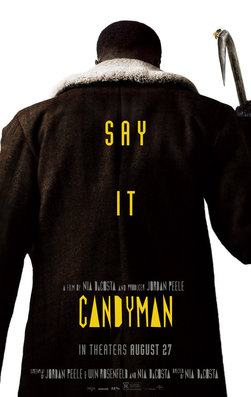
Nowhere near as sweet as he sounds, the urban legend of Candyman is rooted in the bitter realities of racism at the hands of white supremacy, birthing a monster and personifying the terrors of oppression. Arguably ahead of its time, the origins of the frightful hook handed menace stem from the realities of a history not so long ago, placing the slasher film and systemic racism alongside each other to induce the greatest levels of fear.
The son of slaves and a product of the sinister consequences of the Jim Crow era, Bernard Rose’s Candyman (1992) places on the big screen the constantly perpetuated message that the Black man must be feared. Told from the perspective of graduate student Helen Lyle, the motivations of the Cabrini-Green bogeyman are touched upon but fall back to the shadows as focus is placed upon the downward mental spiral of the white female protagonist. Regardless of the tragedy and the senseless violence that surrounds his death, Candyman is, however, dehumanised due his own acts of rage and mental manipulation. With the tether between Lyle and Candyman, his past trauma as consequence for his interracial love repeats itself as he latches on to the grad student, again remaining unheard.
Nearly thirty years later, but not far enough from the past, the clever and refreshing impact of Jordan Peele’s stamp on the horror genre along with the insightful, spine shivering storytelling of Nia DaCosta set up the Candyman (2021) revival to continue to comment on the racial horrors of the time. However, aware of the missteps of the past, and a refusal to plainly lay out the socially relevant undertones that transcend the simple slasher, Peele and DaCosta leave no room for error. Flipping the narrative on its head, and looking through the eyes of Candyman himself, the audience is forced to remove themselves from the standpoint of the fearful and empathise from the perspective of the feared.
Through the eyes of Anthony McCoy (Yahya Abdul-Mateen II), an upcoming artist, and a Black man in the now gentrified Cabrini-Green projects, Candyman does not only represent the urban legend, but also symbolises the consequences of passing on racially stimulated traumas. Despite the centuries of oppression and shape shifting for societal comfortability that the Black man has faced, Peele’s Candyman is no longer viewed as the terroriser of the white female victim. Rather he is the oppressed and the oppressor, thrashing out in fits of violent anger in response to a lifetime of brutal mistreatment. As McCoy summons the evils of Candyman, the multidimensionality of the villain is exposed, revealing an unsettling kinship between the two and a desperate need to free themselves of the traumas that follow them.
With a frightful social context touching on the scariness of our reality, from police brutality to the subconscious villainizing of the Black man, all intricately mixed into the jump scares and heart racing musical scores of the horror, Candyman scares you once, and then all over again, as you scream, think and dissect the scenes, unravelling perspectives you never thought about until they had to become your own.
